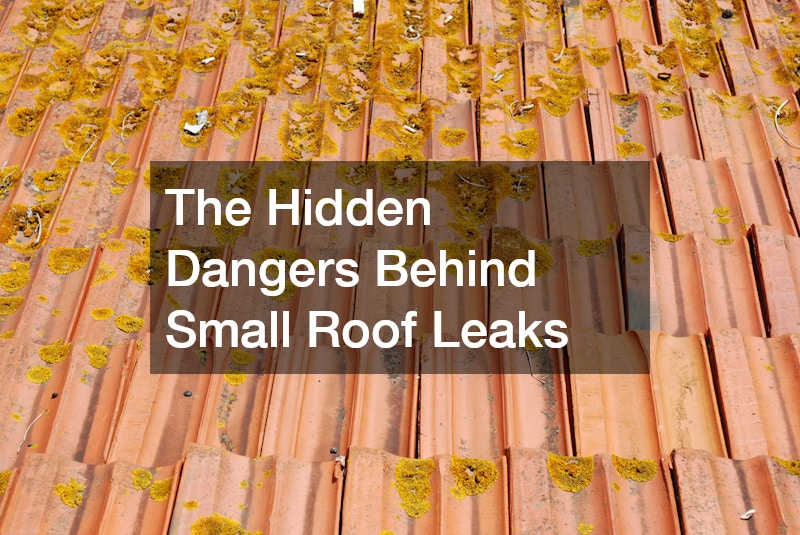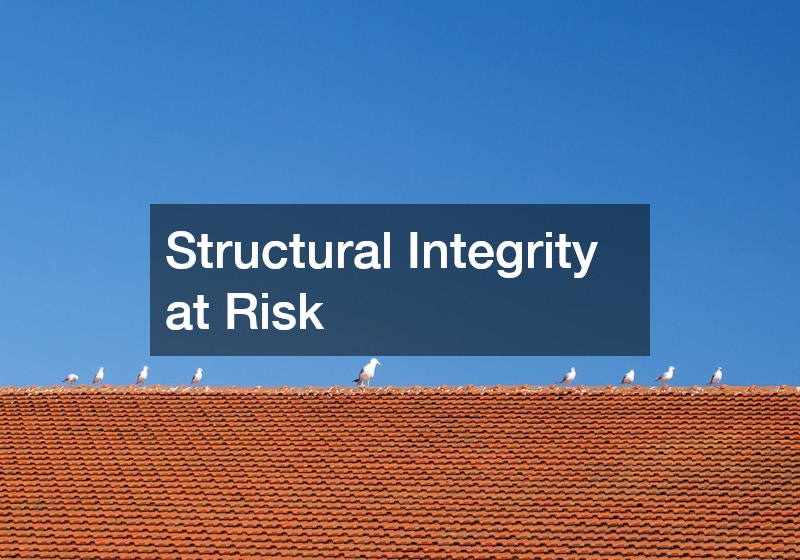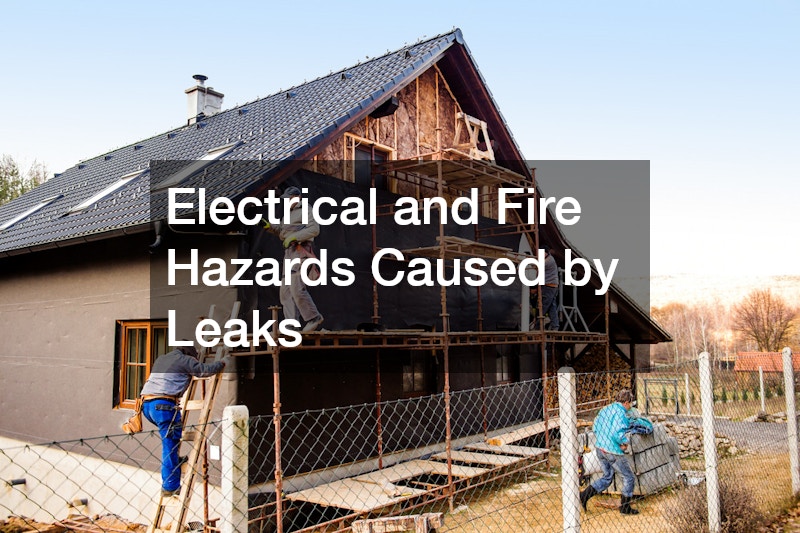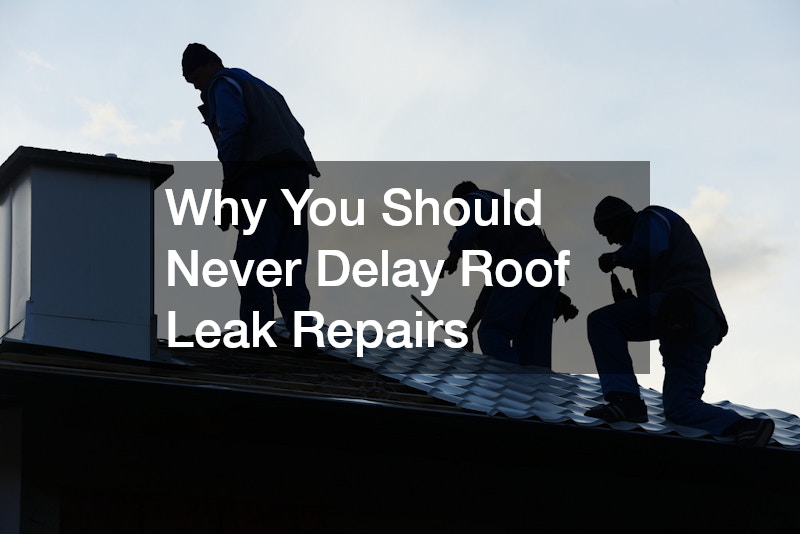A roof leak may seem like a small nuisance at first—a minor drip, a faint stain on the ceiling, or a little moisture near a vent or skylight. Many homeowners tend to put off addressing early leak signs because the damage appears manageable or intermittent. However, leaks should never be dismissed as minor issues. Moisture intrusion is one of the most destructive forces a home can face because it weakens structures silently and spreads far beyond the initial entry point. What begins as a slow drip can evolve into extensive structural damage, costly repairs, health hazards, and long-term deterioration that affects the entire property. Understanding why immediate action is essential can save you time, money, and stress. Roof leaks do not resolve themselves, and the longer they are ignored, the more serious the consequences become.

The Hidden Dangers Behind Small Roof Leaks
One of the biggest misconceptions homeowners have about roof leaks is the idea that the damage is contained only where the water appears. Moisture has a way of traveling through roofing layers, insulation, and structural components before becoming visible. Because of this, even a tiny exterior breach can cause widespread internal harm long before a homeowner notices a visible sign like a ceiling stain.
Moisture accumulation inside roofing systems creates the perfect environment for mold. Once mold begins growing, it can spread rapidly and compromise indoor air quality. What makes this especially concerning is that mold often grows silently behind walls, inside ceilings, and within insulation. By the time homeowners detect a musty odor or visible mold development, the colonies are already well-established.
Water infiltration also diminishes the effectiveness of insulation. Wet insulation loses its thermal resistance, leading to increased heating and cooling costs. Over time, this moisture saturation invites condensation problems, which can trigger further deterioration. Structural components, including rafters, trusses, and decking, can also weaken from long-term exposure. Wood rot sets in quietly and spreads through organic materials, compromising the very framework that supports the roof.
Another issue is that water traveling within the structure may result in short circuits or electrical hazards. Wiring located in crawl spaces or attics can come into contact with moisture, increasing the risk of sparks, system malfunctions, or home fires. Many homeowners do not associate roof leaks with electrical danger, yet this is an overlooked but serious threat.
These invisible forms of damage make it clear that addressing leaks promptly is essential. The delay allows moisture to affect more areas, greatly increasing the extent of damage and the cost of repairs. Immediate action can prevent these cascading issues from becoming widespread.
Some homeowners seek help from a roofing contractor after recognizing the long-term risks of hidden moisture damage.
Increasing Repair Costs the Longer You Wait
Ignoring roof leaks is not just a structural or safety risk—it also leads to significantly higher repair bills. The financial consequences of delaying roof leak repairs grow rapidly, and homeowners are often shocked by how quickly costs escalate.
Leaks enlarge over time as water continues to erode shingles, underlayment, flashing, and roofing deck materials. What could have been resolved with a quick patch or localized repair soon becomes a large-scale project. When leaks spread beyond the immediate entry point, professionals must remove and replace more roofing materials to restore the system’s integrity.
Water entering the attic or crawl space can damage insulation. Wet insulation often requires full replacement, which becomes an added expense for homeowners. Furthermore, ruined insulation leads to poor temperature regulation, creating higher monthly utility bills until the material is restored.
Structural issues, such as wood rot in rafters or decking, also contribute significantly to rising repair costs. Replacing structural components is considerably more involved and expensive than surface-level roof repairs. In severe cases, large sections of the roof deck must be replaced before new shingles or other roofing materials can be installed.
Secondary interior repairs can add thousands of dollars to final restoration costs. Water entering the home often damages ceilings, drywall, flooring, and even cabinetry. Once stains, swelling, or warping occur, cosmetic and structural interior work becomes necessary.
The compounding nature of water damage dramatically increases the overall cost. Taking action early is the single best way to keep repair bills manageable. Addressing leaks promptly stops the spread before it affects more of the home’s structure and interior.
To restore damaged surfaces, some homeowners turn to roofing services after recognizing the financial burden that comes with delaying repairs.

Structural Integrity at Risk
Structural stability is one of the most important aspects of a safe home. Roof leaks threaten this essential stability because water weakens building materials over time. The roof structure relies on layers of wood, insulation, and protective materials working together to withstand weather conditions. When water infiltrates these systems, the structural framework begins to degrade.
Roof decking, which supports the roofing material above, becomes soft and compromised when exposed to moisture. Once weakened, decking can sag, warp, or collapse under weight. This poses a serious hazard, especially in regions that experience heavy rain, snow, or wind.
Rafters and trusses, which carry the load of the roof, are also vulnerable. Wood rot spreads gradually throughout these components, making them incapable of supporting the weight they were designed to bear. This structural weakening often remains unseen until the damage is extensive.
Even metal fasteners and connectors can corrode when exposed to moisture. Rust weakens their hold, leading to structural movement or instability. This corrosion increases the likelihood of roof failure, especially during storms.
Interior framing, drywall, and flooring can also absorb moisture and deteriorate. Over time, this damages the structural layout of the home. Delayed repairs mean that simple leaks evolve into issues affecting multiple load-bearing walls and floors.
When foundational components weaken, the home becomes more vulnerable to additional problems. Sagging roofs, shifting structures, and compromised stability pose dangerous safety hazards to occupants. The cost of reinforcing or replacing structural elements can be enormous compared to the cost of early leak repairs.
Many homeowners consult a roofing installation professional when the damage progresses to structural deterioration.
Mold, Mildew, and Indoor Air Quality Issues
Roof leaks can quickly become a health hazard when moisture creates a breeding ground for mold and mildew. These microorganisms thrive in damp, warm environments, making attic spaces and wall cavities ideal for colonization.
Once mold begins spreading, it can release airborne spores that circulate throughout the home. This affects indoor air quality and poses risks for individuals with asthma, allergies, or respiratory conditions. Long-term exposure can cause headaches, fatigue, sinus congestion, and other health concerns.
The biggest challenge with mold is that it often grows out of sight. Homeowners may unknowingly breathe contaminated air while the mold continues to expand. When it finally becomes visible on walls or ceilings, the infestation is usually advanced.
Removing mold can be an expensive and labor-intensive process. It requires specialized equipment, containment procedures, and professional remediation services. Delaying leak repairs increases the likelihood of severe mold outbreaks that require extensive cleanup.
Even mildew, while less dangerous than mold, is still problematic. It causes odors, discoloration, and material deterioration. Bathroom-like smells near the attic or upper levels of a home often indicate moisture problems originating from roof leaks.
Improving ventilation, reducing humidity, and repairing leaks promptly are all essential steps in preventing mold and protecting your home’s air quality.
Some homeowners reach out to roofing companies when mold begins to appear near leak sites.

Electrical and Fire Hazards Caused by Leaks
Many people are surprised to learn that roof leaks can cause electrical issues and even fires. Electrical systems run throughout the home, including ceiling spaces, attics, and wall cavities—precisely where roof leaks tend to spread.
When water comes into contact with electrical wiring, junction boxes, or light fixtures, it can lead to short circuits. Faulty wiring becomes a fire hazard, especially when moisture causes the insulation around electrical wires to degrade.
Water entering recessed lighting fixtures can cause flickering, malfunctioning, or dangerous electrical arcing. This puts the home at immediate risk.
Corrosion caused by moisture can damage electrical components, making them unstable over time. Even after the leak is repaired, the electrical system may still require replacement or rewiring if corrosion has occurred.
Fire hazards from roof leaks are not uncommon. In fact, many residential fires are linked to electrical failures caused by water intrusion. Homeowners often notice the warning signs—flickering lights, buzzing sounds, or outlets that stop working—but do not connect these problems to a roof leak.
The cost of repairing electrical issues is far greater than addressing the initial source of moisture. Delay only increases the danger, expense, and extent of damage.
Many individuals consult roofers when electrical problems begin accompanying a leak.
Energy Loss and Higher Utility Bills
The ability of a home to maintain a consistent indoor temperature depends heavily on insulation and air sealing. Roof leaks compromise both of these systems, leading to higher energy consumption.
Wet insulation loses its thermal resistance. Once saturated, it cannot effectively retain warm or cool air. As a result, the HVAC system must work harder to maintain comfortable indoor temperatures.
This increased workload not only shortens the lifespan of HVAC equipment but also raises monthly utility bills. Energy inefficiency continues as long as the insulation remains wet or compromised, even if the leak stops temporarily.
Moisture also increases the chance of air leaks forming around rooflines, vents, and structural connections. These gaps allow conditioned air to escape, forcing heating and cooling systems to compensate.
Condensation caused by moisture can further degrade insulation and attic materials. Ice dams, another roof-related issue, worsen energy loss when attic insulation is affected by water intrusion.
Addressing roof leaks promptly is essential for controlling energy costs. Preventing moisture from entering the thermal envelope of the home protects both comfort and energy efficiency.
Some homeowners hire roof repair professionals to address leaks after noticing higher utility bills.

Damage to Attic and Interior Spaces
The attic is often the first area impacted when a roof leak occurs. Unfortunately, many homeowners rarely check attic spaces, allowing damage to continue unnoticed.
Moisture can ruin stored items, including clothing, documents, decorations, and valuables. Cardboard boxes deteriorate quickly when exposed to water, creating soggy messes that may conceal mold growth.
Insulation becomes saturated and heavy. Over time, the added weight can cause the ceiling below to sag. Paint may bubble, plaster may soften, and drywall may crack or crumble as moisture spreads downward.
Leaks that reach interior spaces can damage walls, flooring, and furniture. Wooden flooring can warp, laminate can swell, and carpets can grow moldy. Even tile flooring can suffer damage if moisture seeps under the subfloor.
Painted surfaces become discolored or stained. Water streaks on walls often indicate significant internal moisture distribution.
Lighting fixtures attached to ceilings can become compromised when water collects around them. This not only affects their function but also creates hazardous conditions.
Addressing leaks promptly protects the entire living space. Ignoring them jeopardizes the comfort and safety of the home.
Some individuals contact residential roofing experts when attic moisture begins affecting interior rooms.
Pest Infestations Linked to Roof Leaks
Moisture attracts pests, making roof leaks a gateway for unwanted invaders. Many insects and rodents seek damp environments for nesting, feeding, and breeding.
Termites, carpenter ants, and other wood-destroying insects thrive in soft, weakened wood. Once moisture compromises roofing structures, these pests can infiltrate and create colonies that further weaken the framework.
Rodents such as mice and rats often enter through damaged roof openings created by leaks. Once inside, they can chew wiring, contaminate insulation, and spread disease.
Moisture also attracts silverfish, cockroaches, centipedes, and earwigs. These pests multiply quickly in damp spaces such as attics and wall cavities.
Birds may also take advantage of softened roof materials or openings near eaves. Nesting birds can cause additional structural damage and introduce mites or parasites.
Once pests infest the home, removal requires professional extermination services, repairs to damaged areas, and ongoing prevention measures. This can become costly and time-consuming.
Fixing leaks early prevents moisture conditions that attract pests and eliminates one of the most common entry pathways into the home.
Some homeowners work with metal roof installers when moisture damage begins, allowing pest activity around the roofline.
Protecting Home Value and Preventing Depreciation
A well-maintained roof is essential for preserving property value. Roof leaks, on the other hand, lead to rapid depreciation because they signal underlying problems that concern potential buyers.
Home inspectors thoroughly check for moisture damage, stains, soft spots, mold, and structural weakness. Even a small leak can result in inspection reports that lower the value of the home or deter buyers entirely.
Visible water damage is one of the biggest red flags for real estate professionals. Buyers associate leaks with costly repairs, health risks, and long-term maintenance concerns. They may request significant concessions or even walk away from the purchase.
Insurance complications can also affect home value. Some insurance providers may deny claims or raise rates for homes with a history of untreated water damage.
Keeping the roof in good condition demonstrates responsible homeownership and helps maintain curb appeal. A roof free of leaks contributes to longevity, durability, and energy efficiency—qualities buyers find attractive.
Addressing leaks early is one of the most effective ways to protect your investment and safeguard your property’s resale value.
Some homeowners consult a roofing specialist after learning how leaks influence property appraisals.
Insurance Issues Stemming from Delayed Repairs
Many homeowners are surprised to learn that insurance companies may not cover damage resulting from long-neglected roof leaks. Insurance policies typically require homeowners to maintain their properties and act promptly when issues arise.
If an investigation reveals that damage occurred because the homeowner ignored early warning signs, the claim may be denied. This often results in thousands of dollars in out-of-pocket expenses.
Insurance policies also limit coverage for mold remediation, structural replacement, or interior restoration if the cause is deemed preventable. Roof leaks fall squarely into this category when homeowners delay repairs.
Another issue involves depreciation adjustments. If the roof is already aged or poorly maintained, insurance companies may reduce the amount they will pay toward repairs.
Some policies even exclude coverage for wear-and-tear damage entirely. This means that a small leak left unaddressed becomes the homeowner’s sole financial responsibility.
Prompt action protects insurance eligibility. Maintaining a leak-free roof demonstrates good faith and meets policy requirements for timely care.
Some individuals call a roofing company after learning that delayed repairs may void their insurance coverage.
Roof leaks are far more dangerous than they appear. Even small leaks can cause structural damage, mold growth, electrical hazards, interior deterioration, energy loss, and insurance complications. Delaying repairs only increases the severity of these problems and makes restoration more costly. Addressing leaks promptly protects your home’s safety, stability, and value. No matter the cause or severity of the leak, taking immediate action ensures your home remains secure, efficient, and comfortable for years to come.
